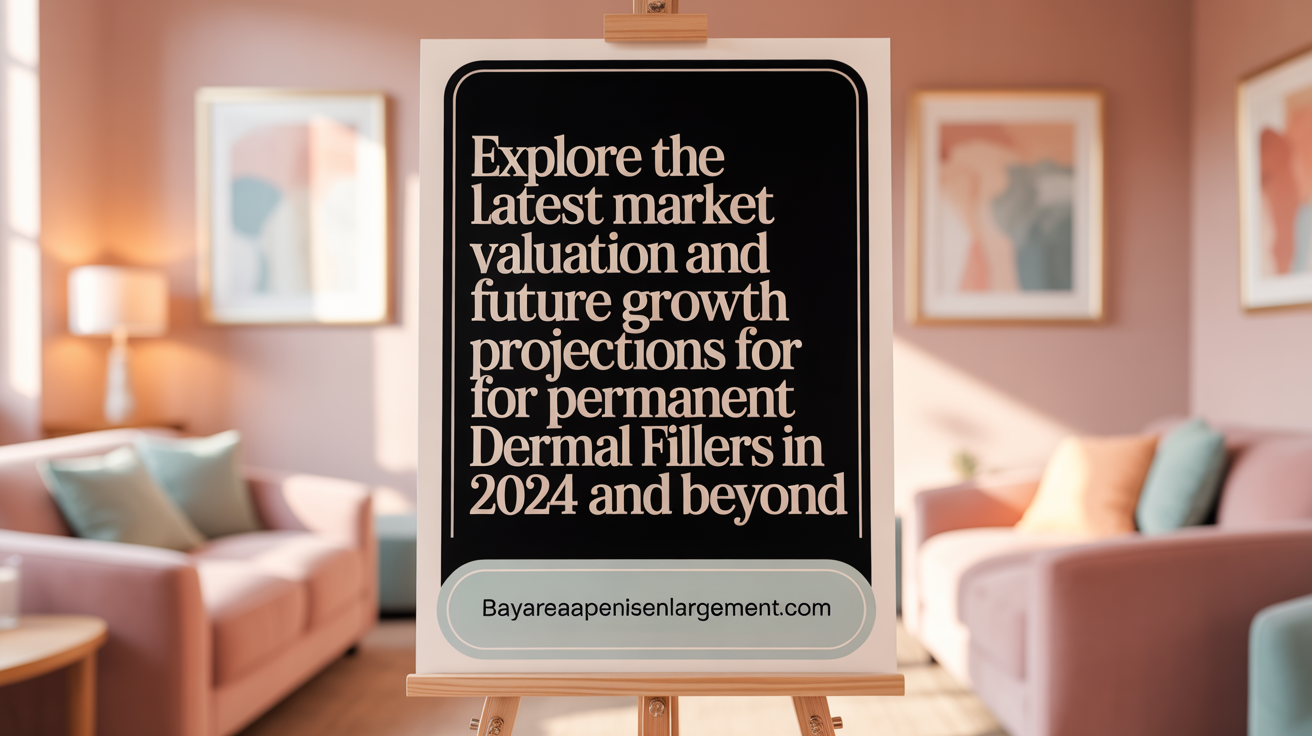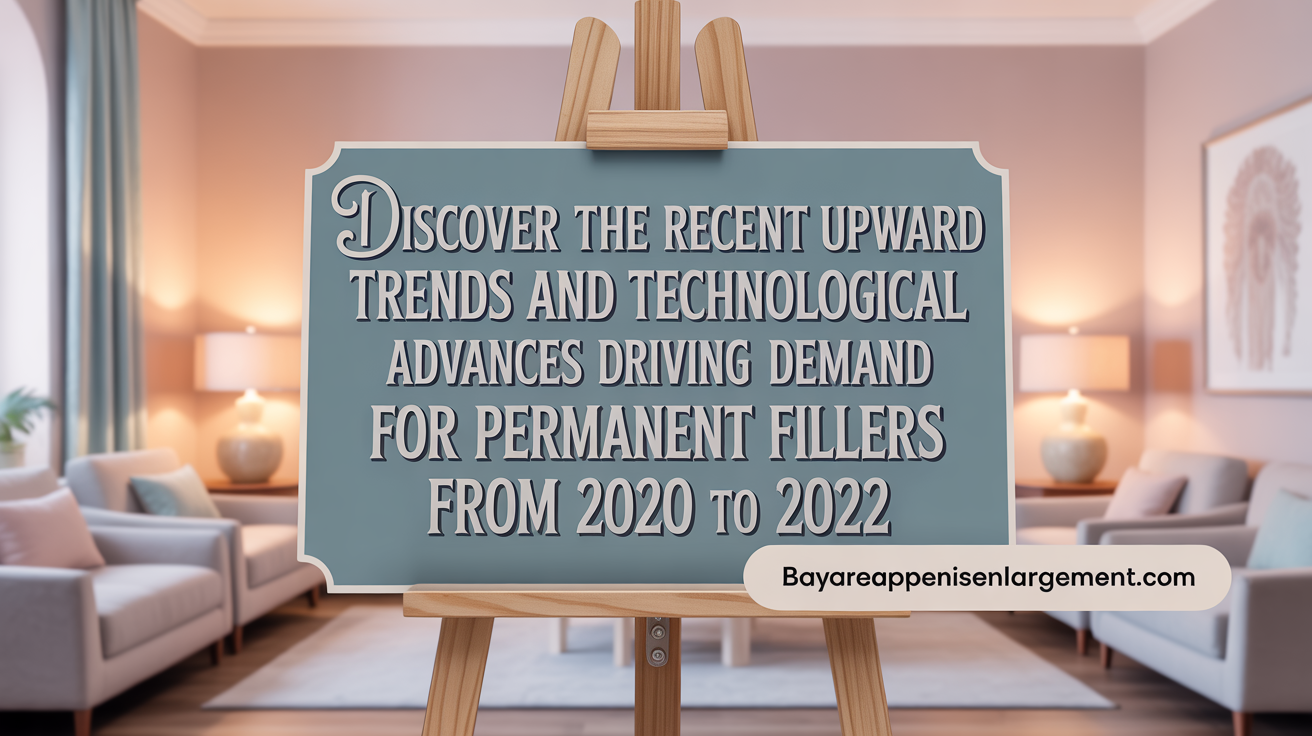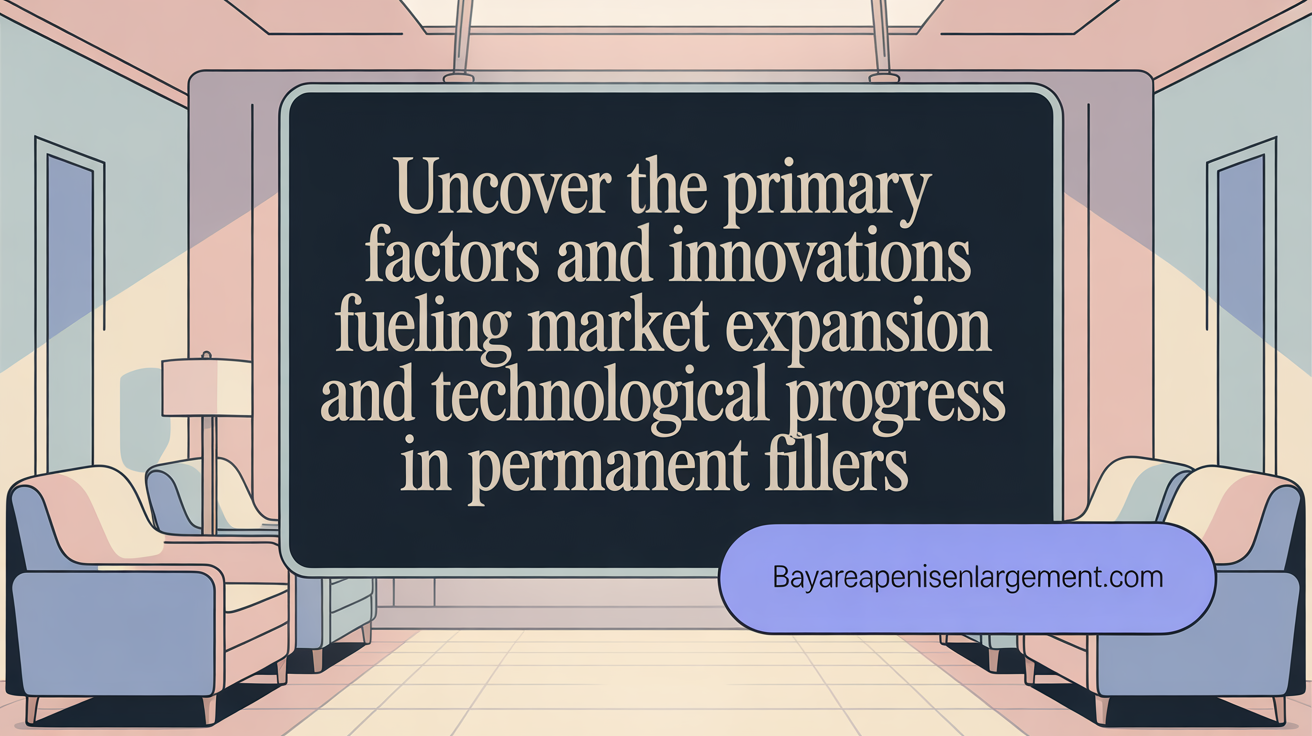Understanding the Dynamics of Permanent Filler Demand Growth
The demand for permanent dermal fillers, a niche yet evolving segment within the expansive dermal fillers market, has been steadily growing. This article delves into the year-over-year growth trends of permanent fillers, exploring market size, driving factors, scientific research, and future outlooks. We leverage robust market data, industry insights, and bibliometric analyses to provide a comprehensive understanding of this dynamic sector, essential for investors, practitioners, and stakeholders navigating this growing landscape.
Current Market Size and Demand Outlook for Permanent Dermal Fillers

What is the current market size and demand outlook for permanent dermal fillers?
The global market for dermal fillers in 2024 was valued at approximately USD 7.6 billion, highlighting the significant scale of the industry.
While temporary and semi-permanent fillers currently dominate, the demand for permanent fillers is gradually increasing. However, their market share remains limited—less than 5%—due to concerns over higher risks and the irreversibility of procedures.
Projections indicate that the overall dermal fillers market will continue to expand robustly, with the global valuation expected to surpass USD 15.7 billion by 2034. This growth is fueled by increasing consumer interest in aesthetic enhancements.
North America, especially the United States, leads the regional markets. The U.S. market is projected to grow from USD 1.77 billion in 2024 to over USD 4 billion by 2034, driven by rising popularity of non-invasive procedures and technological innovation.
Meanwhile, Asia-Pacific is emerging as a high-growth region, supported by medical tourism, economic progress, and increased awareness. Countries like China, India, Australia, and South Korea are at the forefront of this surge.
The demand outlook remains positive, supported by technological advancements improving safety and results, as well as expanding applications for fillers in facial rejuvenation and correction. Consistent growth rates of around 8-10% CAGR are expected over the next decade, reflecting sustained industry momentum.
Year-Over-Year Growth Trends in Permanent Filler Demand (2020-2022)

What are the year-over-year growth trends in permanent filler demand from 2020 to 2022?
From 2020 to 2022, the demand for permanent fillers has been on a gradual rise. Overall, the dermal fillers market experienced strong growth, supported by the increasing popularity of minimally invasive aesthetic procedures.
Although specific annual growth rates for permanent fillers are not directly provided, the broader market data shows a significant upward trend. For example, in 2023, over 3 million dermal filler procedures were performed in the United States alone, reflecting a 15% increase over the previous five years. This escalation indicates a rising preference for various filler options, including permanent types.
Moreover, the global interest in non-invasive cosmetic procedures surged, contributing to increased market activity. The growth of bio-degradable hyaluronic acid fillers, which now account for over 75% of procedures and have reduced complications by 30%, also demonstrates the technological progress making such treatments more appealing.
Demand for permanent fillers, which currently accounts for less than 5% of the market due to higher risks and irreversibility, is beginning to grow in certain regions. However, the bulk of the growth has been centered around temporary and semi-permanent options, with semi-permanent fillers expected to grow at a CAGR of 10.4%. The overall trend indicates a positive, yet cautious, increase in permanent filler demand aligned with the broader market expansion in aesthetic medicine.
Key Growth Drivers and Industry Developments Influencing Permanent Fillers

What are the key growth drivers and industry developments influencing the permanent filler market?
The market for permanent dermal fillers is shaped by several influential factors that continue to propel its growth. One of the primary drivers is the increasing desire among consumers for longer-lasting aesthetic solutions. As societal beauty standards evolve, there is a rising demand for products that offer durable results, especially among individuals seeking to maintain a youthful appearance without frequent treatments.
Technological progress plays a crucial role. Innovations in filler materials and application techniques have improved safety profiles, reduced complications, and extended the longevity of results. New formulations, including bio-compatible and composite materials, allow for more natural and lasting outcomes, enticing a broader audience.
Demographic and societal factors also significantly impact market expansion. The aging global population creates a higher need for facial rejuvenation procedures that are both effective and minimally invasive. Rising disposable incomes across developing and developed nations enable more consumers to access aesthetic treatments, including permanent options.
Industry developments further catalyze market growth. The launch of advanced AI-powered treatment planning tools enhances precision, increases practitioner confidence, and improves patient satisfaction. Meanwhile, efforts to establish clear regulatory standards and improve practitioner training ensure procedures are performed safely, restoring and maintaining public trust.
Emerging application areas, such as preventative aging treatments among younger demographics and male aesthetic procedures, diversify market demand. This shift is complemented by rising acceptance of aesthetic enhancements across various cultures.
In summary, the synergy of scientific innovation, favorable demographic trends, expanding applications, and regulatory improvements contributes to the robust growth of the permanent dermal fillers market, setting the stage for continued industry advancements and market penetration.
Evolution and Future Growth Outlook for Permanent Fillers

How has the demand for permanent fillers evolved over time, and what is the future growth outlook?
Historically, the demand for permanent dermal fillers has been relatively modest compared to temporary and semi-permanent options. This is mainly due to concerns about higher risks, irreversibility, and potential complications associated with permanent fillers. However, over time, consumer interest in long-lasting aesthetic results has increased, especially as technological improvements have enhanced safety and efficacy.
The overall market trajectory indicates a steady growth trend in the popularity of permanent fillers, although they currently account for less than 5% of total market share globally. Regional variations are notable, with some countries experiencing increased demand due to local preferences and market awareness.
Looking ahead, the future growth outlook for permanent fillers remains cautiously optimistic. Market projections suggest that the global dermal fillers market will reach approximately USD 11.7 billion by 2035, with an overall CAGR of around 7.6% to 8.3%. Emerging treatment options, a demand for longer-lasting results, and advancements in formulation technology are expected to fuel incremental growth in permanent filler use.
Innovations such as safer, more controllable formulations and combination treatments are likely to make permanent fillers more appealing. Moreover, the rising awareness of aesthetic procedures, demographic shifts towards an aging population, and increased consumer desire for personalized, durable solutions will further enhance demand.
Despite these optimistic trends, safety concerns and regulatory scrutiny will continue to influence the rate of adoption. The industry’s evolution towards safer, reversible, and more natural options suggests a cautious but positive future for permanent fillers in the aesthetic medicine landscape.
Statistical Analysis and Market Projections for Permanent Fillers
What statistical analyses and market projections are available for permanent fillers in recent years?
Studies and reports primarily focus on the overall dermal filler market, with limited specific data on the permanent fillers segment. Nonetheless, recent industry analyses reveal a significant growth trend for the entire market.
In 2023, the global dermal filler industry was valued at around USD 6.3 billion. Projections suggest it will expand to approximately USD 16.8 billion by 2033, indicating a compound annual growth rate (CAGR) of about 10.3%. This robust growth is driven by factors such as aging populations, increasing consumer awareness, and technological advances.
Market segmentation analyses are multilevel, examining product types—such as biodegradable and non-biodegradable fillers—and geographic regions including North America, Europe, and Asia-Pacific. These projections highlight North America as the dominant force, while Asia-Pacific is expected to have the highest growth rate, at around 11.5% CAGR.
While specific statistical evaluations for permanent fillers are relatively scarce, industry experts suggest that their growth potential remains promising, particularly driven by innovations in safety and effectiveness. Researchers anticipate that future analyses will focus on safety profiles, longevity, and patient acceptance of permanent options, offering more targeted insights.
Overall, the trend suggests that although permanent fillers constitute a niche, they may experience increased demand as technological improvements mitigate associated risks.
| Market Segment | 2023 Value (USD billion) | 2033 Projection (USD billion) | CAGR (%) | Main Drivers |
|---|---|---|---|---|
| Overall Dermal Fillers | 6.3 | 16.8 | 10.3 | Aging populations, minimally invasive procedures |
| Permanent Fillers | N/A | Growing in regions with increasing aesthetic demands | N/A | Safety improvements, aesthetic longevity |
Future statistical evaluations will likely provide more precise insights into this specific segment, helping stakeholders understand its evolving role within the broader dermal filler industry.
Scientific Research and Bibliometric Studies on Permanent Filler Demand
What scientific research and bibliometric studies exist related to permanent filler demand and market trends?
Currently, there is a scarcity of specific research dedicated solely to the demand for and market trends of permanent facial fillers. Most existing studies and bibliometric analyses focus on soft tissue fillers in general, particularly hyaluronic acid-based products used widely in facial rejuvenation. These analyses, covering publications from 2000 to 2022, reveal a growing academic interest, especially from leading institutions like the Mayo Clinic and universities in Munich and California.
While scientific literature extensively discusses the technical aspects, safety concerns, and complications of temporary and semi-permanent fillers, there is limited focus on permanent fillers. Market reports, however, provide a broader overview. The global dermal fillers market was valued at approximately USD 6.3 billion in 2023 and is projected to reach USD 16.8 billion by 2033, at a Compound Annual Growth Rate (CAGR) of around 10.71%.
Analysis of industry reports highlights that demand for permanent fillers remains modest, accounting for less than 5% of the total market. This limited adoption is mainly due to higher risks, irreversibility, and safety concerns associated with permanent options. Despite this, increasing regional demand in specific markets and advancements in formulations could influence future preferences.
Market dynamics are further fueled by technological innovations, new product approvals, and rising awareness of minimally invasive procedures. In North America, the demand is particularly high, driven by aesthetic preferences and an expanding practitioner base, with around 3 million dermal filler procedures performed in the U.S. alone in 2023. Historically, research emphasizes safety and technique improvements but lacks specific bibliometric focus on permanent fillers.
In conclusion, though the industry and scientific community recognize the growing excitement around dermal fillers, targeted bibliometric and scientific studies focusing on permanent filler demand and comprehensive market trends are still emerging. As the market advances and consumer preferences evolve, more focused research is expected to further illuminate the trajectory and safety landscape of permanent facial fillers.
Market Segmentation: Temporary, Semi-Permanent, and Permanent Fillers
What are the relative market shares of different filler types?
The dermal fillers market is predominantly composed of temporary fillers, which held a dominant 68.7% share in 2024. Hyaluronic acid-based fillers, the most commonly used type, are part of this segment and account for approximately 70% of all dermal procedures across North America.
Semi-permanent fillers are gaining popularity, with a projected compound annual growth rate (CAGR) of 10.4%. These fillers offer longer-lasting results than temporary options but with fewer risks compared to permanent fillers.
Permanent fillers, however, constitute less than 5% of the total market, mainly due to concerns over their irreversibility and higher risk profile. Despite this, certain regions are beginning to see increased interest in permanent solutions.
What are the growth rates of semi-permanent and permanent fillers?
Semi-permanent fillers are experiencing a steady growth, expected to grow at a CAGR of 10.4%. This trend is driven by consumer preference for longer-lasting effects with manageable safety profiles. Conversely, the demand for permanent fillers remains low but is increasing in select markets, fueled by the desire for permanent correction and advancements that mitigate risks.
Overall, the entire market is witnessing a robust growth trend, with an anticipated CAGR of over 9% to 10% during the forecast period, reflecting evolving consumer preferences and technological improvements.
What are material preferences and clinical applications?
Hyaluronic acid remains the gold standard material, favored for its biocompatibility, safety, and versatility. It features prominently in facial rejuvenation, lip enhancement, and scar treatments.
Other materials include calcium hydroxyapatite, poly-L-lactic acid, and poly methyl methacrylate (PMMA), used in specific applications like volume restoration and deeper tissue augmentation.
Clinically, dermal fillers are widely used for various purposes such as wrinkle correction, facial volume restoration, facial lifting, and acne scar treatment. The preference for biodegradable options, especially hyaluronic acid, is bolstered by technological advancements that have led to fewer complications, such as a 30% reduction in adverse events.
The ongoing innovations in formulations and expanding application areas continue to drive growth across all segment types, indicating a dynamic and evolving market landscape.
Regional Market Dynamics and Growth Patterns in Permanent Filler Demand

North America dominance and market size
The North American dermal fillers market remains the largest globally, with a valuation of USD 1,487.28 million in 2024. The United States leads this region, performing over 3 million dermal filler procedures in 2023, a significant 15% increase over five years. This growth is driven by increased consumer awareness, technological advancements, and a preference for minimally invasive cosmetic procedures. Hyaluronic acid-based fillers dominate this market, accounting for roughly 70% of procedures, largely due to their safety and effectiveness.
Asia-Pacific rapid growth and factors
Meanwhile, the Asia-Pacific region is projected to experience the highest compounded annual growth rate (CAGR) of approximately 11.52% through 2035. Factors fueling this rapid expansion include rising economic development, increased medical tourism, and greater consumer awareness about aesthetic treatments. Countries like Australia and India are at the forefront, benefiting from expanding healthcare infrastructure and a growing middle class seeking non-invasive cosmetic solutions.
Impact of medical tourism and social media
Medical tourism plays a pivotal role in boosting demand in regions like Latin America, especially Mexico, where lower costs attract international patients. Social media influence further amplifies this trend, making aesthetic procedures more popular and accessible worldwide. The proliferation of before-and-after images and celebrity endorsements has significantly raised public interest, accelerating the adoption of dermal fillers across various demographics.
| Region | Market Size (USD Million, 2024) | Growth Drivers | Notable Countries/Factors |
|---|---|---|---|
| North America | 1,487.28 | Tech innovation, rising awareness, strong healthcare infrastructure | U.S. leading with 88.58% regional share |
| Asia-Pacific | Leading CAGR of 11.52% | Economic growth, medical tourism, social media influence | Australia, India, rapid urbanization |
| Latin America | Growing demand, lower costs | Medical tourism hub, affordability | Mexico, increasing clinics and practitioners |
Technological Innovations Driving Permanent Filler Market Expansion
Advances in filler materials and formulations
Recent technological progress has significantly improved the materials used in dermal fillers. Biodegradable hyaluronic acid (HA) fillers now account for over 75% of procedures in North America, highlighting their safety and effectiveness. These advances have resulted in more natural-looking results and reduced complication rates by approximately 30%. Additionally, semi-permanent fillers are gaining popularity, expected to grow at a CAGR of 10.4%, driven by innovative formulations that extend their longevity while maintaining safety. New materials such as poly-L-lactic acid and calcium hydroxyapatite are also being refined for enhanced durability and biocompatibility.
Introduction of AI in treatment planning
Artificial intelligence (AI) is beginning to influence aesthetic treatment planning, offering personalized approaches that improve outcomes. AI algorithms analyze patient data, facial morphology, and aesthetic goals to recommend optimal injection sites and filler types. These technological tools help practitioners achieve more precise results, reducing errors and enhancing patient satisfaction. AI-driven planning also streamlines procedures, making non-invasive treatments more accessible and predictable.
Impact on safety and consumer confidence
Technological innovations have contributed to safer procedures, with advanced formulations reducing adverse effects and complications. Bio-degradable HA fillers, for example, have lowered risks associated with permanent fillers, making treatments more appealing to cautious consumers. As safety improves, consumer confidence increases, fueling the demand for facial rejuvenation procedures. In turn, this growth supports the expanding market, projected to reach USD 8.8 billion by 2035.
| Aspect | Innovation | Effect |
|---|---|---|
| Materials | Bio-degradable HA, Poly-L-lactic acid | Safer, longer-lasting results |
| Technologies | AI-assisted treatment planning | Increased precision and predictability |
| Safety | Reduced complications, better biocompatibility | Higher consumer confidence |
This rapid pace of innovation continues to drive market expansion, encouraging both new and experienced practitioners to incorporate advanced techniques and materials into their practice.
Consumer Demographics and Behavior Influencing Permanent Filler Demand
Age and gender distribution
The typical demographic for dermal fillers has traditionally been individuals over 40, with 57% of recipients aged between 40 and 59 as of 2017. This age group primarily seeks treatments for facial rejuvenation and age-related volume loss. However, as awareness and acceptance grow, younger populations are increasingly exploring dermal fillers for preventive aesthetics and subtle enhancements.
Emerging demand among men and younger clients
While women comprise the majority of dermal filler users, recent data indicate a rising trend among men and younger clients. Men pursuing aesthetic procedures have seen a notable increase, driven by changing beauty standards and workplace competitiveness. Younger clients, particularly those in their 20s and 30s, are turning to fillers for early intervention, aiming for natural-looking results and maintaining a youthful appearance.
Motivations such as anti-aging and natural appearance
The primary motivations for dermal filler use include anti-aging and facial rejuvenation. Many consumers now prefer minimally invasive options that offer natural results and quick recovery times. The desire for a subtle enhancement rather than dramatic change has shifted treatment goals, encouraging practitioners to focus on personalized, natural-looking outcomes.
Understanding these evolving consumer behaviors helps shape market dynamics, influencing the development of diversified product offerings and targeted marketing strategies. As preferences lean towards subtle, long-lasting, and safe procedures, the demand for more personalized and innovative filler options, including permanent variants, is expected to continue growing.
Industry Competition and Market Concentration in the Permanent Fillers Segment
The market for dermal fillers shows a high level of concentration, especially in the segment of permanent fillers, which account for less than 5% of the overall market. Major players like Allergan, Galderma, and Merz Pharma dominate this space, holding a significant combined market share. These companies are investing heavily in product innovation and strategic collaborations to sustain their competitive edge.
Product innovation is a critical aspect, with the industry focusing on reducing risks such as irreversibility and complications associated with permanent fillers. Advances include the development of safer, more biocompatible materials like hyaluronic acid-based formulations, although these still represent the temporary filler segment.
The competitive landscape is shaped by ongoing research, regulatory approvals, and marketing strategies. Barriers to entry remain high due to the need for significant research investments, strict regulations, and the necessity for extensive clinical testing. Despite the dominance of established brands, new entrants face challenges such as high R&D costs and the need for innovative formulations that meet safety standards.
Overall, the concentration of market power among leading companies and ongoing product development underscore a competitive industry that prioritizes safety, efficacy, and technological advancement to maintain their market positions.
Summary and Future Perspectives on Permanent Filler Demand
The permanent dermal filler market, while currently representing a smaller segment compared to temporary and semi-permanent fillers, exhibits a promising growth trajectory fueled by evolving consumer preferences, technological advances, and expanding clinical applications. Year-over-year data from 2020 to 2022 indicate increasing acceptance and adoption, supported by a broader rise in minimally invasive aesthetic procedures. Statistical projections and market analyses suggest sustained double-digit growth, particularly in key regions like North America and Asia-Pacific. Despite limited targeted scientific studies specifically on permanent fillers, the general trend within the dermal fillers industry is one of robust expansion driven by innovation and demographic shifts. Looking ahead, ongoing advancements in formulation safety, regulatory standards, and personalized treatment approaches are expected to further solidify permanent fillers as a valuable option within aesthetic medicine, offering stakeholders and investors compelling opportunities within a competitive yet growing sector.
References
- North America Dermal Facial Fillers Market Size & Share, 2033
- Dermal Facial Fillers Market Analysis to 2033 - Global Growth Insights
- Dermal Fillers Market Growth, till 2035 - Roots Analysis
- Dermal Fillers Market Size Worth $7.58 Billion, Globally, by 2031 ...
- Dermal Filler Statistics 2023 | Everything You Need To Know
- Hyaluronic Acid-based Dermal Fillers Market Report, 2030
- The Research Trend of Soft Tissue Filler Injection from 2000 to 2022
- From extreme to mainstream: The future of aesthetics injectables

